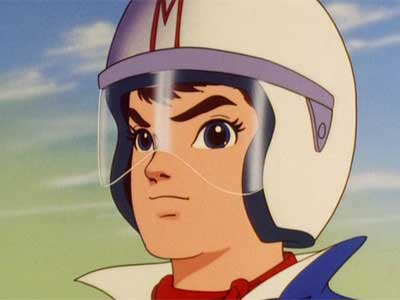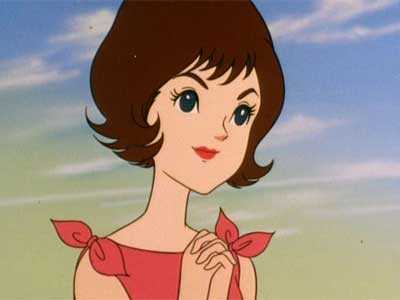I used to watch Speed Racer when it aired on MTV late at night (back in the mid-1990). It was then that I knew I loved retro-futurism.

Speed Racer (originally called Mach Go Go Go) was first created by anime pioneer Tatsuo Yoshida (1933-1977) as a manga series in the 1960s and made the jump to TV as an anime series in 1967. The central character in the anime and manga was a young race car driver named GÅ Mifune (三船剛 Mifune GÅ). Yoshida selected the names and symbolisms in his creation very carefully. The M logo on the hood of his race car and the front of his helmet stood for his family name Mifune, an homage to Japanese film star Toshiro Mifune (and not “Mach 5” as the dub would suggest). His given name GÅ is also a Japanese homonym for the number 5 (the number on his race car). This is also represented by the letter G embroidered on his shirt. The names themselves constitute a multi-lingual wordplay of the kind that started become part of the Japanese popular culture of the time.

The English rights to Mach Go Go Go were immediately acquired by American syndicator Trans-Lux. The main character Go Mifune was given the name “Speed Racer” in the English version. A major editing and dubbing effort was undertaken by producer Peter Fernandez, who also voiced many of the characters, including Speed Racer himself. Fernandez was also responsible for a retooling of the theme song’s melody and its subsequent English lyrics. When the series emerged before U.S. TV audiences as Speed Racer, fans were quickly drawn to its sophisticated plots involving fiendish conspiracies, violent action, hard-driving racing, and soulful characters with sparkling eyes. In an effort to squeeze the complicated plotlines into existing lip movements, the frenetic pace of the dubbing made Speed Racer famous for its quirky “fast” dialogue.



It was great to run across this post when looking for some classic Speed Racer pics. I really appreciate the explanation of the M5 aspect. Thanks!
I’m glad you liked the post. Thanks for commenting.
Hi, I grew up in Okinawa, Japan, in the middle to late 1960’s so I grew up watching the original Japanese versions of Speed Racer. The explanation of the “M” and “G” and “5” are spot on.
But’s it’s still, to this day, strange to me to see the Japanese title referred to as “Mach Go Go Go”. That might be the English translation but in Japanese, it’s said and I’m spelling phonetically, it’s said “Maha Go Go”. If you can find the Japanese version of the song, you can clearly hear it.
At the end of the new movie I got really excited because they actually started playing it but then it morphed into this stupid, asinine, hip-hop, rap, version before you hear any of the lyrics.
Maybe they’ll have it on the DVD version when it comes out. Hope so.
I went to see the new movie last night. It wasn’t what I expected, but it was still pretty entertaining. It’s the closest thing I’ve seen to a real-life cartoon… The colors were amazing.
Great Post , Thank you
I’ve already read bad reviews about this movie. I expected nothing but stupidity from the previews. I mean, I never watched the show, I only saw clips from watching a segment called ‘Adult Swim’ on Cartoon Network, and they would show obscure things like that every now and then. I never had a good impression of it, and then I saw several references to it in the show Family Guy, bieng a major fan of the show, which didn’t help Speed Racer’s reputation either, since after everything Speed and his father said, they went, ‘Ha ha!’ But watching the movie really shocked me. These people weren’t trying to make this cartoon into something super sophisticated and adult. They just wanted to make it really high tech and flashy, and in my opinion, artistic. I mean the colors of this movie are gorgeous, I’m buying the movie just for that! It’s so vibrant!
What I love is a movie that doesn’t pretend to be something it’s not. This movie is quorky, simple, with cheesy dialogue, and little plotline, and they rub it in your face with neon lights, and I shout HOORAH!!!